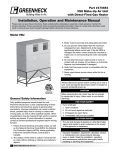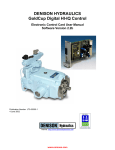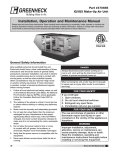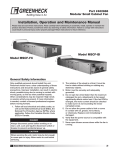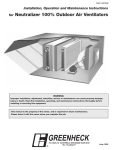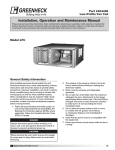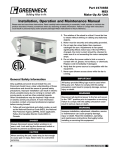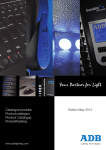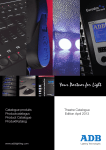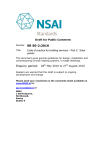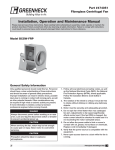Download Greenheck Fan DGX Part #470655 User's Manual
Transcript
Part #470655 Model DGX Industrial Space Heating ® Installation, Operation and Maintenance Manual Please read and save these instructions for future reference. Read carefully before attempting to assemble, install, operate or maintain the product described. Protect yourself and others by observing all safety information. Failure to comply with instructions could result in personal injury and/or property damage! Model DGX General Safety Information Only qualified personnel should install this unit. Personnel should have a clear understanding of these instructions and should be aware of general safety precautions. Improper installation can result in electric shock, possible injury due to coming in contact with moving parts, as well as other potential hazards. Other considerations may be required if high winds or seismic activity are present. If more information is needed, contact a licensed professional engineer before moving forward. 1. Follow all local electrical and safety codes, as well as the National Electrical Code (NEC), the National Fire Protection Agency (NFPA), where applicable. Follow the Canadian Electrical Code (CEC) in Canada. 2. The rotation of the wheel is critical. It must be free to rotate without striking or rubbing any stationary objects. 3. Motor must be securely and adequately grounded. 4. Do not spin fan wheel faster than the maximum cataloged fan rpm. Adjustments to fan speed significantly affects motor load. If the fan RPM is changed, the motor current should be checked to make sure it is not exceeding the motor nameplate amps. 5. Do not allow the power cable to kink or come in contact with oil, grease, hot surfaces, or chemicals. Replace cord immediately if damaged. 6. Verify that the power source is compatible with the equipment. 7. Never open blower access doors while the fan is running. ® DANGER Always disconnect power before working on or near a unit. Lock and tag the disconnect switch or breaker to prevent accidental power up. CAUTION When servicing the unit, motor may be hot enough to cause pain or injury. Allow motor to cool before servicing. FOR YOUR SAFETY If you smell gas: 1. Open windows. 2. Do not touch electrical switches. 3. Extinguish any open flame. 4. Immediately call your gas supplier. FOR YOUR SAFETY The use and storage of gasoline or other flammable vapors and liquids in open containers in the vicinity of this appliance is hazardous. WARNING Improper installation, adjustment, alteration, service or maintenance can cause property damage, injury or death. Read the installation, operating and maintenance instructions thoroughly before installing or servicing this equipment. DGX Industrial Space Heating 1 Receiving Upon receiving the product, check to make sure all items are accounted for by referencing the bill of lading to ensure all items were received. Inspect each crate for shipping damage before accepting delivery. Notify the carrier if any damage is noticed. The carrier will make notification on the delivery receipt acknowledging any damage to the product. All damage should be noted on all the copies of the bill of lading which is countersigned by the delivering carrier. A Carrier Inspection Report should be filled out by the carrier upon arrival and reported to the Traffic Department. If damaged upon arrival, file claim with carrier. Any physical damage to the unit after acceptance is not the responsibility of the manufacturer. Unpacking Verify that all required parts and the correct quantity of each item have been received. If any items are missing, report shortages to your local representative to arrange for obtaining missing parts. Sometimes it is not possible that all items for the unit be shipped together due to availability of transportation and truck space. Confirmation of shipment(s) must be limited to only items on the bill of lading. Handling Units are to be rigged and moved by the lifting brackets provided or by the skid when a forklift is used. Location of brackets varies by model and size. Handle in such a manner as to keep from scratching or chipping the coating. Damaged finish may reduce ability of unit to resist corrosion. Storage Units are protected against damage during shipment. If the unit cannot be installed and operated immediately, precautions need to be taken to prevent deterioration of the unit during storage. The user assumes responsibility of the unit and accessories while in storage. The manufacturer will not be responsible for damage during storage. These suggestions are provided solely as a convenience to the user. INDOOR — The ideal environment for the storage of units and accessories is indoors, above grade, in a low humidity atmosphere which is sealed to prevent the entry of blowing dust, rain, or snow. Temperatures should be evenly maintained between 30°F (-1°C) and 110°F (43°C) (wide temperature swings may cause condensation and “sweating” of metal parts). All accessories must be stored indoors in a clean, dry atmosphere. Remove any accumulations of dirt, water, ice, or snow and wipe dry before moving to indoor storage. To avoid “sweating” of metal parts allow cold parts to reach room temperature. To dry parts and packages use a portable electric heater to get rid of any moisture build up. Leave coverings loose to permit air circulation and to allow for periodic inspection. 2 DGX Industrial Space Heating The unit should be stored at least 3½ in. (89 mm) off the floor on wooden blocks covered with moisture proof paper or polyethylene sheathing. Aisles between parts and along all walls should be provided to permit air circulation and space for inspection. OUTDOOR — Units designed for outdoor applications may be stored outdoors, if absolutely necessary. Roads or aisles for portable cranes and hauling equipment are needed. The fan should be placed on a level surface to prevent water from leaking into the unit. The unit should be elevated on an adequate number of wooden blocks so that it is above water and snow levels and has enough blocking to prevent it from settling into soft ground. Locate parts far enough apart to permit air circulation, sunlight, and space for periodic inspection. To minimize water accumulation, place all unit parts on blocking supports so that rain water will run off. Do not cover parts with plastic film or tarps as these cause condensation of moisture from the air passing through heating and cooling cycles. Inspection and Maintenance during Storage While in storage, inspect fans once per month. Keep a record of inspection and maintenance performed. If moisture or dirt accumulations are found on parts, the source should be located and eliminated. At each inspection, rotate the fan wheel by hand ten to fifteen revolutions to distribute lubricant on motor. Every three months, the fan motor should be energized. If paint deterioration begins, consideration should be given to touch-up or repainting. Fans with special coatings may require special techniques for touch-up or repair. Machined parts coated with rust preventive should be restored to good condition promptly if signs of rust occur. Immediately remove the original rust preventive coating with petroleum solvent and clean with lint-free cloths. Polish any remaining rust from surface with crocus cloth or fine emery paper and oil. Do not destroy the continuity of the surfaces. Wipe thoroughly clean with Tectyl® 506 (Ashland Inc.) or the equivalent. For hard to reach internal surfaces or for occasional use, consider using Tectyl® 511M Rust Preventive or WD40® or the equivalent. REMOVING FROM STORAGE — As units are removed from storage to be installed in their final location, they should be protected and maintained in a similar fashion, until the equipment goes into operation. Prior to installing the unit and system components, inspect the unit assembly to make sure it is in working order. 1. Check all fasteners, set screws on the fan, wheel, bearings, drive, motor base, and accessories for tightness. 2. Rotate the fan wheel(s) by hand and assure no parts are rubbing. ® Table of Contents Installation Clearance to Combustibles/Service Clearances. . . 3 Indoor Unit. . . . . . . . . . . . . . . . . . . . . . . . . . . . . . . . 4 Unit Arrangement DB / HZ. . . . . . . . . . . . . . . . . . . . 5 Diffuser. . . . . . . . . . . . . . . . . . . . . . . . . . . . . . . . . . . 6 Remote Panel (TSCP) . . . . . . . . . . . . . . . . . . . . . . . 6 Electrical Wiring. . . . . . . . . . . . . . . . . . . . . . . . . . . . 7 Gas Piping. . . . . . . . . . . . . . . . . . . . . . . . . . . . . . 8-9 Start-Up Blower . . . . . . . . . . . . . . . . . . . . . . . . . . . . . . . . 9-10 Direct Gas . . . . . . . . . . . . . . . . . . . . . . . . . . . . 11-14 100% Outdoor Air. . . . . . . . . . . . . . . . . . . . . . . . 11 50/50 Recirculation . . . . . . . . . . . . . . . . . . . . . . 12 Operation Electrical without 7-Day Timer. . . . . . . . . . . . . . . . 15 Electrical with 7-Day Timer . . . . . . . . . . . . . . . . . . 16 Troubleshooting Clearance to Combustibles / Service Clearances Insulated/ Units Non Insulated Units Floor Top Sides Ends 0 inches 0 inches 0 inches 0 inches (0 mm) (0 mm) (0 mm) (0 mm) 6 inches 6 inches 6 inches 0 inches (0 mm) (152.4 mm) (152.4 mm) (152.4 mm) Clearance to combustibles is defined as the minimum distance required between the heater and adjacent combustible surfaces to ensure the adjacent surface’s temperature does not exceed 90 degrees above the ambient temperature. Recommended Minimum Service Clearances 42 inches (1066.8 mm) Housing 32 and less on the controls side of the unit 48 inches (1219.2 mm) Housing 35 and higher on the controls side of the unit Clearances for component removal may be greater than the service clearances listed. Blower . . . . . . . . . . . . . . . . . . . . . . . . . . . . . . . . . . 17 Motor. . . . . . . . . . . . . . . . . . . . . . . . . . . . . . . . . . . 18 Insufficient Airflow / Too Much Airflow . . . . . . . . . 19 Excessive Noise or Vibration. . . . . . . . . . . . . . . . . 20 Heater. . . . . . . . . . . . . . . . . . . . . . . . . . . . . . . . 21-23 Maintenance Routine. . . . . . . . . . . . . . . . . . . . . . . . . . . . . . . 24-25 Fall. . . . . . . . . . . . . . . . . . . . . . . . . . . . . . . . . . . . . 26 Reference Gas Train Layout, 400-800 MBH. . . . . . . . . . . . . . 27 Gas Train Layout, > 800 MBH . . . . . . . . . . . . . . . . 27 Control Center Layout / Dirty Filter Switch. . . . . . 28 Start-Up Check List. . . . . . . . . . . . . . . . . . . . . . . . 29 Maintenance Log. . . . . . . . . . . . . . . . . . . . . . . 30-31 Warranty. . . . . . . . . . . . . . . . . . . . . . . . . . Backcover ® DGX Industrial Space Heating 3 Installation of Indoor Unit NOTE 1. Install Hangers Install threaded hangers from ceiling supports. When locating hangers, allow enough room to open access panel(s). Be sure to allow for the recommended diffuser height outlined in the Diffuser installation section, page 6. Two nuts must be used on the end of each threaded hanger. Ceiling supports are supplied by others. Refer to diagram below. NOTE Refer to the Diffuser installation section, page 6, for instructions on mounting the diffuser. Good duct practices should be followed for all ductwork. Ductwork should be installed in accordance with SMACNA and AMCA guidelines, NFPA 96 and any local codes. Reference the CAPS submittal for duct sizes. 3. Seal Wall Opening Apply sealant around the perimeter of the weatherhood to prevent water penetration and drafts into the building. Sealant 2. Install Unit Using sheet metal screws, attach the weatherhood/ thru-wall/filter section to the blower/burner section. The flange on the weatherhood/thru-wall/filter section should overlap the flange on the blower/burner section. Sealant NOTE 50/50 units are shipped with the louvered intake assembled to the unit and do not require a thru wall weatherhood. Seal Wall Opening Raise the assembled unit into place. Using two nuts per hanger, fasten the unit supports to the hangers under the unit. Appropriate unit supports, such as the optional manufacturer hanging bracket kit, or c-channel and angle iron (supplied by others), should be used. Refer to the Indoor Mounting drawing. In order to prevent the unit from swinging and to provide a safe environment for service and maintenance, additional measures must be taken to secure the unit in all directions. Ceiling Supports Diffuser Hangers Unit Supports Indoor Mounting NOTE Two nuts must be used on each end of each threaded hanging rod for proper support. 4 DGX Industrial Space Heating ® Installation of Arrangement DB / HZ 1. Install Curb and/or Equipment Support(s) Position curb/equipment support(s) on the roof (reference the CAPS submittal for placement of curb/ equipment support(s) inRoof relation to the unit). Verify that Curb unit supports are level; shim if necessary. Attach curb to roof and flash into place. Attach the equipment support(s) to the roof, remove Metal Cover metal cover, flash to wooden nailer and Equipment Roof Curb reinstall cover. Support 4. Install Unit Use a crane and a set of spreader bars hooked to the factory lifting lugs to lift and center the unit on the curb/ equipment support(s). Use self-tapping sheet metal screws to fasten the unit to the curb/equipment support(s). 2. Install Ductwork Good duct practices should be followed for all ductwork. All ductwork should be installed in accordance with SMACNA and AMCA guidelines, NFPA 96 and all local codes. Reference the CAPS submittal for ductwork sizes. NOTE The use of a duct adapter is recommended on a downblast (DB) arrangement to align the ductwork with the supply unit. The duct adapter is only a guide and is not to be used as support for the ductwork. 3. Apply Sealant Apply an appropriate sealant around the perimeter of the curb and duct adapter(s) to isolate fan vibration and prevent water penetration. Setting Unit NOTE The use of all lifting lugs and a set of spreader bars is mandatory when lifting the unit. 5. Assemble and Attach Weatherhood The weatherhood can now be assembled and attached to the unit. Detailed assembly instructions can be found with the weatherhood. Supply Air Ductwork (Arrangement DB only) 6. Seal Weatherhood Seam Sealant Using an appropriate sealant, seal the seam between the weatherhood and the unit. Ductwork Complete Rooftop Installation ® DGX Industrial Space Heating 5 Installation of Diffuser and Remote Panel (TSCP) 2. Install TSCP When installing the TSCP Space Heat Remote Panel, the location is critical to performance of the Greenheat™ System. The TSCP should be installed five to six feet above the floor. It is recommended that the TSCP be installed on an outside wall, in the space, and close to any source of infiltration such as dock doors. DO NOT install the TSCP in the blast area of the heater or near any other source of heat. NOTE The location of the discharge diffuser and the TSCP Space Heat Remote Panel are critical for optimum performance of the Greenheat™ System. 1. Install Diffuser Using self-tapping screws, attach diffuser to the ductwork or unit. Be sure to maintain the recommended floor to diffuser height. Refer to the chart for the recommended diffuser height. Important DO NOT install the TSCP in the blast area of the space heater or near any other source of heat. Diffuser Height (feet) Airflow (cfm) Minimum Recommended Maximum 4000 15 20 25 6000 15 20 25 8000 20 20-25 30 10000 20 25-30 35 13000 20000 25 30-35 40 h Recommended TSCP Location Blast Area h Indoor Mounted Unit h TSCP Location h Thru-Wall Diffuser Height Rooftop Unit h Rooftop Diffuser Height 6 DGX Industrial Space Heating ® Installation of Electrical Wiring Important Before connecting power to the unit, read and understand the following instructions and wiring diagrams. Complete wiring diagrams are attached on the inside of the control center door(s). 1. Determine the Size of the Main Power Lines The unit’s nameplate states the voltage and the unit’s MCA. The main power lines to the unit should be sized accordingly. The nameplate is located on the outside of the unit on the control panel side. Voltage, Hertz, Phase Important All wiring should be done in accordance with the latest edition of the National Electrical Code ANSI/ NFPA-70 and any local codes that may apply. In Canada, wiring should be done in accordance with the Canadian Electrical Code. caution If replacement wire is required, it must have a temperature rating of at least 105ºC, except for energy cut-off or sensor lead wire which must be rated to 150ºC. Important The equipment must be properly grounded. Any wiring running through the unit in the airstream must be protected by metal conduit, metal clad cable or raceways. danger High voltage electrical input is needed for this equipment. This work should be performed by a qualified electrician. caution Any wiring deviations may result in personal injury or property damage. Manufacturer is not responsible for any damage to, or failure of the unit caused by incorrect final wiring. Important Manufacturer’s standard control voltage is 24 VAC. Control wire resistance should not exceed 0.75 ohms (approximately 285 feet total length for 14 gauge wire; 455 feet total length for 12 gauge wire). If the resistance exceeds 0.75 ohms an industrial-style, plug-in relay should be wired in place of the remote switch. The relay must be rated for at least 5 amps and have a 24 VAC coil. Failure to comply with these guidelines may cause motor starters to chatter or not pull in, resulting in contactor failures and/or motor failures. ® VOLTS HZ PH SUP HP EXH HP MCA MOP Unit’s Total MCA Electrical Nameplate 2. Provide the Opening(s) for the Electrical Connections Voltage, Hertz, Phase Electrical openings vary by unit size and arrangement and are field supplied. 3. ConnectVOLTS the Main HZ Power PH EXH HP HP power lines Connect theSUP main to the disconnect switch and main grounding lug(s). Torque field connections to MOP MCA 20 in.-lbs. 4. Wire the Optional Convenience Outlet The convenience outlet requires a separate 115V power supply circuit. The circuit must include short circuit protection which may need to be supplied by others. 5. Wire Accessories Reference the Ladder Diagram on the inside of the control center door for correct wiring of the following accessories: • Summer/Off/Winter Switch • Indicating Lights • Dirty Filter Indicator • Industrial Space Heat TSCP NOTE TSCP has number-to-number wiring. DGX Industrial Space Heating 7 Installation of Gas Piping important All gas piping must be installed in accordance with the latest edition of the National Fuel Gas Code ANSI/Z223.1 and any local codes that may apply. In Canada, the equipment shall be installed in accordance with the Installation Code for Gas Burning Appliances and Equipment (CGA B149) and Provincial Regulations for the class. Authorities having jurisdiction should be consulted before installations are made. warning All components of this or any other gas-fired heating unit must be leak tested prior to placing the unit into operation. A soap and water solution should be used to perform this test. NEVER test for gas leaks with an open flame. warning When leak testing pressures that are equal to 14 in. wg (3.5 kPa), first close the field-installed shutoff valve to isolate the unit from the gas supply line. warning When leak testing pressures that are above 14 in. wg (3.5 kPa), close the field installed shutoff valve, disconnect the furnace and gas train from the gas supply line and plug the supply line before testing. important All piping should be clean and free of any foreign matter. Foreign material entering the gas train can damage the valves, regulators and burner. important Do NOT connect the unit to gas types other than what is specified and do NOT connect the unit to gas pressures that are outside of the pressure range shown on the label. NOTE When connecting the gas supply, the length of the run must be considered in determining the pipe size to avoid excessive pressure drop. Refer to a Gas Engineer’s Handbook for gas pipe capacities. 1. Determine the Supply Gas Requirements The unit’s direct gas nameplate states the requirements for the gas being supplied to the unit. The direct gas nameplate is located on the outside of the unit on the control center side. Minimum gas pressure for maximum output MAX BTU/HR BTU/H MAX MIN BTU/HR BTU/H MIN NORMAL MANIFOLD PRESSURE PRESSION DÕADMISSION NORMALE MIN GAS PRESSURE PRESSION DE GAZ MIN BURNER PRESSURE DROP PERTE MIN DE PRESSION DANS LE BRULEUR “ W.C. MIN GAS PRESSURE FOR MAX OUTPUT PRESSION DE GAZ MIN POUR PUISSANCE MAX “ W.C. “ W.C. MAX GAS PRESSURE PRESSION DE GAZ MAX “ W.C. “ W.C. MAX BURNER PRESSURE DROP PERTE MAX DE PRESSION DANS LE BRULEUR PSI DESIGN ∆T ∆T NORMALE TYPE OF GAS NATURE DU GAZ AGAINST EQUIPPED FOR EXTERNAL STATIC PRESSURE “ W.C. SCFM CONTE CONCU POUR F Type of gas PRESSION STATIQUE EXTERIEURE Maximum gas pressure Direct Gas Nameplate 2. Install Additional Regulator if Required When the supply gas pressure exceeds the maximum gas pressure shown on the direct gas nameplate, an additional regulator (by others) is required to reduce the pressure. The regulator must have a listed leak limiting device or it must be vented to the outdoors. NOTE The regulator located inside the unit is used to adjust the unit’s maximum output temperature. 3. Connect the Supply Gas Line A manual shut off valve (gas cock), 1/8 in. plugged test port and 6 in. drip leg must be installed prior to the gas train. The valve and the test port must be accessible for the connection of a test gauge. Supply gas connections must be made by a qualified installer and are not furnished by manufacturer. To Controls Gas Cock Ground Joint Union From Gas Supply 1/8 in. Plugged Tap 6 in. Trap Supply Gas Line 8 DGX Industrial Space Heating ® 4. Pipe the Optional Vent Line If an optional vent line is located between the safety shutoff valves it must be piped to the outdoors. warning Start-Up - Blower Refer to the Start-Up Checklist in the Reference section before proceeding further! Pre Start-Up Check Reference the National Fuel Gas Code for additional vent line requirements. Vent Line Solenoid Vent Line to outdoors to burner Rotate the fan wheel by hand and make sure no parts are rubbing. Check the V-belt drive for proper alignment and tension (a guide for proper belt tension and alignment is provided in the Maintenance, V-Belt Drives section). Check fasteners, set screws and locking collars on the fan, bearings, drive, motor base, and accessories for tightness. warning from supply Safety Shut-Off Valves Disconnect and lock-out all power and gas before performing any maintenance or service to the unit. Failure to due so could result in serious injury or death and damage to equipment. Optional Vent Line SPECIAL TOOLS REQUIRED 5. Test the System for Leaks Check both the supply lines and the factory piping for leaks. Apply a soap and water solution to all piping and watch for bubbling which indicates a leak. warning NEVER test for a gas leak with an open flame. • Voltage Meter (with wire probes) • Amperage Meter • Micro Amp Meter • Tachometer • Thermometer • Incline manometer or equivalent Note The factory piping has been checked for leaks, but should be rechecked due to shipping and installation. Warning Check the housing, blower, and ductwork for any foreign objects before running the blower. 1. Check the Voltage Before starting the unit, compare the supplied voltage, hertz, and phase with the unit and motor’s nameplate information. Voltage, Hertz, Phase DGK VOLTS HZ PH SUP HP MCA MOP Unit’s Total MCA Electrical Nameplate ® DGX Industrial Space Heating 9 tio n Measure the unit’s air volume (cfm) and compare it with it’s rated air volume. If the measured air volume is off, adjust the fan’s RPM by changing/adjusting the drive. Ro Open the blower access door and run the blower momentarily to determine the rotation. Arrows are placed on the blower scroll to indicate the proper direction or reference the example shown. 5. Air Volume Measurement and Check ta 2. Check the Blower Rotation Blower Housing Blower Rotation Note To reverse the rotation on three phase units, disconnect and lock-out the power, then interchange any two power leads. Note To reverse the rotation on single phase units, disconnect and lock-out the power, then rewire the motor per the manufacturer’s instructions. Important If the blower is rotating in the wrong direction, the unit will move some air, but will not perform as designed. Be sure to perform a visual inspection to guarantee the correct blower rotation. 3. Check for Vibration Check for unusual noise, vibration or overheating of the bearings. Reference the Troubleshooting section for corrective actions. Important Excessive vibration may be experienced during the initial start-up. Left unchecked, it can cause a multitude of problems including structural and/or component failure. Note The most accurate way to measure the air volume is by using a pitot traverse method downstream of the blower. Other methods can be used but should be proven and accurate. Important Changing the air volume can significantly increase the motor’s amps. If the air volume is changed, the motor’s amps must be checked to prevent overloading the motor. Note To ensure accuracy, the dampers are to be open when measuring the air volume. 6. Set-Up Optional Components Adjust the settings on the optional components. See the Control Center Layout in the Reference section for location of optional components. • Building Freeze Protection Typical setting: 5 minutes; 45ºF (7ºC) • Dirty Filter Gauge Typical setting: Settings vary greatly for each unit. (see Reference section for adjusting information) Important Generally, fan vibration and noise is transmitted to other parts of the building by the ductwork. To minimize this undesirable effect, the use of heavy canvas duct connectors is recommended. 4. Motor Check Measure the motor’s voltage, amps and RPM. Compare to the specifications. Motor amps can be reduced by lowering the motor RPM or increasing system static pressure. Important Additional starters and overloads may be provided in the make-up air control center for optional exhaust blowers. Any additional overloads must be checked for proper voltage, amps and RPMs. 10 DGX Industrial Space Heating ® Start-Up Direct Gas Start-Up Direct Gas • 100% Outside Air important For proper unit function and safety, follow the start-up procedure in the exact order that it is presented. important This start-up should begin after all of the installation procedures and the blower start-up have been completed. 1. Check the Supply Gas Pressure important Proper air velocity over the burner is critical on direct fired gas units. If the air velocity is not within the unit specifications, the unit will not operate efficiently, may have sporadic shutdowns and may produce excessive carbon monoxide (CO) or other gases. 4a. Set the Burner Air Pressure Differential With the fan running and discharging 70°F (21°C) air, connect a U-Tube manometer to the outer sensing probes (see below) and measure the static pressure across the burner. Check the supply gas pressure and compare it with the unit’s nameplate pressure requirements. Adjust the supply regulator as needed until the supply gas pressure is within the specified range. Minimum and maximum gas pressures for maximum output Outer Sensing Probes 9 MAX BTU/HR BTU/H MAX 8 MIN BTU/HR BTU/H MIN NORMAL MANIFOLD PRESSURE PRESSION DÕADMISSION NORMALE “ W.C. MIN GAS PRESSURE FOR MAX OUTPUT PRESSION DE GAZ MIN POUR PUISSANCE MAX 7 “ W.C. 0.625 - 0.675 in. WC MIN GAS PRESSURE PRESSION DE GAZ MIN BURNER PRESSURE DROP PERTE MIN DE PRESSION DANS LE BRULEUR “ W.C. MAX GAS PRESSURE PRESSION DE GAZ MAX “ W.C. MAX BURNER PRESSURE DROP PERTE MAX DE PRESSION DANS LE BRULEUR DESIGN ∆T ∆T NORMALE TYPE OF GAS NATURE DU GAZ AGAINST EQUIPPED FOR CONCU POUR PSI Measuring the Pressure Drop F EXTERNAL STATIC PRESSURE “ W.C. SCFM CONTE 6 “ W.C. Adjustable Top Baffle The proper static pressure should be between 0.625 and 0.675 inches wc. If needed, evenly adjust the baffles above and below the burner, keeping the burner centered in the opening until the required pressure is obtained. PRESSION STATIQUE EXTERIEURE Airflow Type of gas Direct Gas Nameplate Burner 2. Check the Pilot Gas Pressure Check the pilot gas pressure. The recommended gas pressure is 3 inches wc. Adjust the pilot regulator as needed. See the Gas Train Layout in the Reference section for the location of the pilot pressure test port and pilot regulator. 3. Check the Optional High and Low Gas Pressure Switches Check the settings on the high and low gas pressure switches. The high pressure setting is typically 8 inches wc and the low pressure is setting is typically 3 inches wc. The switches are set at the factory and should not need adjustment. Adjust the setting if needed. See the Gas Train Layout diagram in the Reference section for the high and low pressure switch location. note The purpose of the high and low gas pressure switches is to automatically shutdown the burner if the inlet gas pressure is too low for the burner to safely light, or if the manifold pressure is too high for the burner to operate safely. ® Adjustable Bottom Baffle Burner and Baffles Note When required pressure is obtained, be sure to reconnect the outer sensing probes. important This process may need to be repeated until the proper pressure is achieved. This adjustment will change the air quantity delivered by the unit and therefore the air quantity delivered should be rechecked. Refer to the Blower Start-Up section. Note To increase the static pressure decrease the opening. To decrease the static pressure increase the opening. DGX Industrial Space Heating 11 Start-Up Direct Gas • 50/50 Recirculation 5. Set the Low Fire Time Delay Set the low fire time delay to 75% of its maximum setting. See below for location of the time delay setting. 6. Set the Maximum Firing Rate important Proper air velocity over the burner is critical on direct fired gas units. If the air velocity is not within the unit specifications, the unit will not operate efficiently, may have sporadic shutdowns and may produce excessive carbon monoxide (CO) or other gases. 4b. Set the Burner Air Pressure Differential With the fan running and discharging 70°F air, connect a U-Tube manometer to the outer sensing probes (see below) and measure the static pressure across the burner. Outer Sensing Probes 8 Monitor the unit’s actual temperature rise by placing a thermocouple in the unit’s inlet and a second in the discharge, three duct diameters downstream of the burner. Send the unit to maximum fire by disconnecting and isolating the proper wire on the Maxitrol 14 amplifier. While monitoring the units temperature rise, set the maximum firing rate by adjusting the separate regulator or combined regulator (shown on page 13) until the designed temperature rise is achieved. After setting the maximum firing rate, reconnect the wire to the amplifier. Remove the wire from the #3 terminal to send the unit to maximum fire Low fire setting (LFST) dipswitch 7 0.5 - 0.8 in. WC 6 5 Measuring the Pressure Drop Set the discharge temperature: Typical 140°F Minimum Maximum Typical: 90°F Typical: 140°F Top Baffle Airflow Burner Bottom Baffle The proper static pressure should be between 0.5 and 0.8 inches wc. On units with motors 15 hp and less, adjust the fan rpm by means of the adjustable drive pulley. For units with motors greater than 15 hp, the drive pulley is fixed. To change the fan rpm, a new pulley will have to be acquired. Maxitrol Series 14 note Do not set the burner maximum firing rate based on gas pressure. It should be set based on the unit’s designed temperature rise shown on the direct gas label. MAX BTU/HR BTU/H MAX MIN BTU/HR BTU/H MIN NORMAL MANIFOLD PRESSURE PRESSION D’ADMISSION NORMALE Burner and Baffles Note When required pressure is obtained, be sure to reconnect the outer sensing probes. Note To increase the static pressure, increase the fan rpm. To decrease the static pressure, decrease the fan rpm. MIN GAS PRESSURE PRESSION DE GAZ MIN BURNER PRESSURE DROP PERTE MIN DE PRESSION DANS LE BRULEUR “ W.C. MIN GAS PRESSURE FOR MAX OUTPUT PRESSION DE GAZ MIN POUR PUISSANCE MAX “ W.C. “ W.C. MAX GAS PRESSURE PRESSION DE GAZ MAX “ W.C. “ W.C. MAX BURNER PRESSURE DROP PERTE MAX DE PRESSION DANS LE BRULEUR DESIGN ∆T ∆T NORMALE TYPE OF GAS NATURE DU GAZ AGAINST EQUIPPED FOR F EXTERNAL STATIC PRESSURE “ W.C. SCFM CONCU POUR PSI CONTE PRESSION STATIQUE EXTERIEURE Direct Gas Nameplate 12 DGX Industrial Space Heating ® Start-Up Direct Gas 7. Set the Minimum Firing Rate continued important Setting the maximum firing rate during mild weather conditions may cause the high limit to trip out during extreme conditions requiring manual resetting. note The minimum setting for the maximum firing rate may be higher than required. This is acceptable, the burner will still modulate as needed. note Gas trains are equipped with either a separate regulator and modulating valve or with a combined modulating regulator. note Clockwise rotation increases the temperature rise, counterclockwise rotation decreases the temperature rise. Regulators and Modulating Valves Remove cap to access maximum firing rate adjustment Remove one wire to send the unit to the minimum firing rate Disconnect and isolate one of the wires running to the modulating valve to send the unit to its minimum firing rate. Set the minimum firing rate by adjusting the needle valve as shown in the diagrams on this page. After setting the minimum firing rate, shut off the pilot to ensure that the flame safeguard can still read the main flame signal. Reconnect the wire to the modulating valve and open the pilot shut-off valve. important The proper setting for the minimum firing rate results in a small ribbon of continuous flame across the entire burner. important Do not allow the disconnected wire to come in contact with a potential ground. Damage to the amplifier or transformer could result. note On units with a 42 inch or greater burner, the flame safe guard will automatically shut off the pilot 10 seconds after the burner has been ignited. note Gas trains are equipped with either separate regulators and modulating valves or with a combined modulating regulator. note Adjusting the maximum and minimum fire requires the inlet air sensor to be set higher than the outdoor air temperature in order to start the burner. Once high and low fire have been set, the inlet air sensor should be set to the desired temperature. Minimum firing rate adjustment Separate Regulator and Modulating Valves Minimum firing rate adjustment Maximum firing rate adjustment 8. Set Daytime Temperature Set the daytime temperature setting to the desired daytime space temperature, the daytime temperature setting is located inside the TSCP Space Heat remote panel which should be mounted in the space. Transformer Side View Top View 7-Day Timer (optional) Terminal Strip Night Temperature Setting (optional) Day Temperature Setting Remove one wire to send the unit to the minimum firing rate Combined Modulating Regulator TSCP Space Heat Remote Panel Controls ® DGX Industrial Space Heating 13 Start-Up Direct Gas continued note For units without a 7 day time clock, skip Steps #9 and #10. 9. Set Nighttime Temperature Set the nighttime temperature setting to the desired nighttime space temperature, the nighttime temperature setting is located inside the TSCP Space Heat remote panel which should be mounted in the space. The TSCP Space Heat remote panel controls image is found on page 13. note For the unit to function properly, the daytime temperature setting should always be set higher than the nighttime temperature. 10. Program the 7 Day Time Clock Follow the detailed Programming and Operating Instructions for 7 Day Time Clock that shipped with the unit. Set the timer ON times to the times when the daytime temperature setting is to be used. Set the timer OFF times to the times when the nighttime temperature setting is to be used. 11. Flame Signal Check To measure the flame signal connect a standard DC voltmeter to the flame amplifier test jacks + and - (com) as shown. The flame signal should be above 1.25 VDC and steady. Check the flame signal with the burner at pilot only, minimum fire, mid-fire and high-fire. Flame Signal Check note If the flame signal is not above 1.25 VDC and steady, consult the Troubleshooting section. 14 DGX Industrial Space Heating ® Operation - Electrical Sequence • Without 7-Day Timer • Power passes through N.O. contact on fan relay (RF), which is energized and closed 1. Switch (S2) in Summer Mode • Power passes through N.O. contact on heat relay (RH), which is energized and closed • Power passes through N.C. field-supplied fire contact (FSC) • Power passes through terminal G • Power passes through N.C. contact on supply starter overload (ST1 OL), which is closed if the supply fan has not overloaded • Power passes through N.C contact on optional freeze protection timer (RT4), which is closed if the temperature has remained above the set point. • Power passes to and energizes optional inlet damper (D1), which opens • Power passes to and energizes fan relay (RF) • Power passes to N.O. contact on fan relay (RF), which closes once the fan relay (RF) is activated • Power passes to and energizes supply fan starter (ST1) • N.O. contact on supply fan starter (ST1) is energized and closed • Supply fan (M1) starts 2. Switch (S2) in Winter Mode • If space temperature is less than the daytime temperature setting, the N.O. contact on the temperature sensor (TS) closes • Power passes through N.C. field-supplied fire contact (FSC) • Power passes to and energizes the heat relay (RH) • Power passes to and energizes terminal 5 on the Flame Safeguard (FSG) • Power passes through N.C. contact on high temperature limit control (HLC1), which remains closed if the temperature has remained below the HLC1 set point • Power passes through optional N.C. and N.O. high and low gas pressure contacts (PS4 and PS3), which are both closed if the gas pressure is within the set range • Power passes to terminal 6 on the Flame Safeguard (FSG) • Flame Safeguard (FSG) begins direct gas burner sequence (See Flame Safeguard Sequence) 3. Flame Safeguard (FSG) Sequence • Verifies proper airflow with airflow switch (PS2) • Verifies no flame is present at burner • Initiates 10 second prepurge • Sends power to open pilot valve (V1) and energizes the spark generator (SG) (clicking of the spark generator may be heard) • Energizes spark generator for up to 10 seconds to light pilot and confirm flame • Powers the main gas valve (V2) open • Power passes through terminal W1 and then energizes the space heat relay (RS) • Shuts down spark generator (SG) • Power passes through N.O. contact on the space heat relay (RS), which is energized and closed • Performs self-diagnostic check every four seconds • Continuously monitors the flame and airflow • Power passes through terminal G • Power passes through N.C. contact on supply starter overload (ST1 OL), which is closed if the supply fan has not overloaded • Power passes through N.C. contact on optional freeze protection timer (RT4), which is closed if the temperature has remained above the set point • Power passes to and energizes optional inlet damper (D1), which opens • Power passes to and energizes fan relay (RF) • Power passes to N.O. contact on fan relay (RF), which closes once the fan relay (RF) is activated • Power passes to and energizes starter relay (ST1) • N.O. contact on supply fan starter (ST1) is energized and closed • Supply fan (M1) starts ® DGX Industrial Space Heating 15 Operation - Electrical Sequence With 7-Day Timer 1. Switch (S2) in Summer Mode • Power passes through N.C. field-supplied fire contact (FSC) • Power passes through terminal G • Power passes through N.C. contact on supply starter overload (ST1 OL), which is closed if the supply fan has not overloaded • Power passes through N.C contact on optional freeze protection timer (RT4), which is closed if the temperature has remained above the set point. • Power passes to and energizes optional inlet damper (D1), which opens • Power passes to and energizes fan relay (RF) • Power passes to N.O. contact on fan relay (RF), which closes once the fan relay (RF) is activated • Power passes to and energizes supply fan starter (ST1) • N.O. contact on supply fan starter (ST1) is energized and closed • Supply fan (M1) starts • Power passes through N.O. contact on fan relay (RF), which is energized and closed • Power passes to and energizes the heat relay (RH) • Power passes through N.O. contact on heat relay (RH), which is energized and closed • Power passes to and energizes terminal 5 on the Flame Safeguard (FSG) • Power passes through N.C. contact on high temperature limit control (HLC1), which remains closed if the temperature has remained below the HLC1 set point • Power passes to and energizes supply fan starter (ST1) • Power passes through optional N.C. and N.O. high and low gas pressure contacts (PS4 and PS3), which are both closed if the gas pressure is within the set range • N.O. contact on supply fan starter (ST1) is energized and closed • Power passes to terminal 6 on the Flame Safeguard (FSG) • Supply fan (M1) starts • Flame Safeguard (FSG) begins direct gas burner sequence (See Flame Safeguard Sequence) 2. Switch (S2) in Winter Mode • If space temperature is less than the daytime temperature setting, the N.O. contact on the temperature sensor (TS1) closes and power passes to the timer (TC1). If the timer (TC1) is on, power passes through N.C. field-supplied fire contact (FSC). If the timer (TC1) is off, but the space temperature is less than the nighttime temperature setting, the N.O. contact on the temperature sensor (TS2) closes and power passes through N.C. fieldsupplied fire contact (FSC) 3. Flame Safeguard (FSG) Sequence • Verifies proper airflow with airflow switch (PS2) • Verifies no flame is present at burner • Initiates 10 second prepurge • Sends power to open pilot valve (V1) and energizes the spark generator (SG) (clicking of the spark generator may be heard) • Energizes spark generator for up to 10 seconds to light pilot and confirm flame • Power passes through terminal W1 and then energizes the space heat relay (RS) • Powers the main gas valve (V2) open • Power passes through N.O. contact on the space heat relay (RS), which is energized and closed • Continuously monitors the flame and airflow • Power passes through terminal G • Shuts down spark generator (SG) • Performs self-diagnostic check every four seconds • Power passes through N.C. contact on supply starter overload (ST1 OL), which is closed if the supply fan has not overloaded • Power passes through N.C. contact on optional freeze protection timer (RT4), which is closed if the temperature has remained above the set point • Power passes to and energizes optional inlet damper (D1), which opens • Power passes to and energizes fan relay (RF) • Power passes to N.O. contact on fan relay (RF), which closes once the fan relay (RF) is activated 16 DGX Industrial Space Heating ® Troubleshooting Blower Does Not Operate Proper supply power at main disconnect No Check Main Voltage (See Blower Start-Up – Step #1) Main Disconnect (DS1) Off (Turn Main Disconnect DS1 On) Primary Fuses Blown (Replace Fuses) Yes 24 VAC between terminals R and X? No Main Transformer (TR1) Defective (Replace Transformer) Yes 24 VAC between terminals G and X? No Yes 24 VAC across terminals 3 and X? No Yes 24 VAC across terminals 4 and X? No Yes Supply Fan Overload (ST1 OL) Tripped (Reset and check motor amps, reference Blower Start-Up – Step #4) Optional Exhaust Fan Interlocks (ST2-ST5) Open (Correct/Replace) (Optional) Freeze Protection (RT4) Tripped (Reset) Yes 24 VAC across A2 and A1 on supply contactor (ST1) Supply Switch (S2) Off (Turn Supply Switch (S2) On) Fire system contact (FSC) tripped/not installed (Correct/Replace) No (Optional) Damper Limit Switch (DL1) Holding (Wait for actuator to open fully or adjust limit switch) (Optional) Damper Limit Switch Jumper Missing (Install jumper, reference the unit’s ladder diagram for terminals) Fan Relay (RF) is not energized (Check for loose connection; repair or replace relay) Broken Fan Belt (Replace - reference V-Belt Drives in the Maintenance section) Defective motor or capacitor (Repair/Replace) Blown Motor Fuse (Replace) One or more legs of 3 phase is out (Restore missing legs) At this time the supply contactor (ST1) should pull in, passing power to the supply motor and the blower should start. ® DGX Industrial Space Heating 17 Troubleshooting Motor Overamps Air volume too high? Yes Adjust drives or increase external static pressure as needed. (Reference Blower Start-Up – Step #5) No Actual static pressure lower than design? Yes No Blower rotation correct? Adjust drives to reduce blower RPM. No Reverse blower rotation. (Reference Blower Start-Up – Step #2) Yes Motor voltage correct? No Provide proper power supply. (Reference Blower Start-Up – Step #1) Yes Motor horsepower too low? Yes No Shorted windings in motor? Yes Resize motor. Yes Replace motor. Everything is working properly, consult factory. 18 DGX Industrial Space Heating ® Troubleshooting Insufficient Airflow Damper(s) not fully opened? Yes Adjust damper linkage(s), or replace faulty actuator(s). (Damper actuators may take a few minutes to open) No System static losses too high? Yes No Blower speed too low? Reduce losses by improving ductwork. Yes No Filters dirty or clogged? Adjust drives as needed. Yes Clean or replace filters. (Reference Filters in the Maintenance section). No Leaks in ductwork? Yes No Belt slipping? Repair leaks. Yes Replace or tighten belt. (Reference V-Belt Drives in the Maintenance section) Yes Everything is working properly, consult factory. Too Much Airflow Blower speed too high? Yes No Filters not in place? Adjust drives as needed. (Reference Blower Start-Up – Step #5) Yes No Insufficient external static pressure? Install filters. Yes No Everything is working properly, consult factory. ® Increase external static pressure. DGX Industrial Space Heating 19 Troubleshooting Excessive Noise or Vibration Belts worn or loose? Yes Replace worn belts or tighten loose belts. (Reference V-Belt Drives in the Maintenance section) No Sheaves aligned? No Align sheaves. (Reference V-Belt Drives in the Maintenance section) Yes Wheel(s) unbalanced? Yes Clean and/or balance wheel(s). No Bearings worn or need lubrication? Yes Replace worn bearings or lubricate bearings as needed. (Reference Bearings in the Maintenance section) No Wheel(s) rubbing on inlet? Yes Adjust wheel(s) or inlet. No At this time noise and vibration should be at acceptable levels. 20 DGX Industrial Space Heating ® Troubleshooting Heater Does Not Operate Does not attempt to light (No visible spark) 24 VAC between terminals W1 and X? No Yes 115 VAC between terminals 102 and 101? No Yes 115 VAC between terminals 103 and 101? No Heat Switch (S4) Off (Turn Heat Switch (S4) On) Heat Switch Not Wired (Wire Heat Switch (S4)) Primary Fuses Blown (Replace Fuses) Main Transformer (TR4) Defective (Replace Transformer) (Optional) Inlet Air Sensor (TS4) Holding (Adjust TS4 setting. Reference Blower Start-Up – Step #6) Heat Relay (RH) Defective (Replace Heat Relay (RH)) Yes The power light on the flame safeguard should blink approximately every 5 seconds as it performs a self-diagnostics check. 115 VAC between terminals 104 and 101? No High Limit (HLC1) Tripped (Reset/Replace High Limit (HLC1)) (Check on cause of control loss) Yes 115 VAC between terminals 106 and 101? No Yes Continuity between terminals 107 and 108? Yes No (Optional) High/Low Gas Pressure Switch(es) (PS3 and PS4) Tripped (Correct gas pressure and reset) (Reference Direct Gas Start-Up – Steps #2 and #3) Airflow Switch (PS2) Holding for Proper Airflow (Correct airflow across burner) (Reference Direct Gas Start-Up – Step #4a or 4b) At this time the heater should attempt to light. (The pilot light on the flame safeguard should illuminate). ® DGX Industrial Space Heating 21 Troubleshooting Heater Does Not Operate Attempts to light, but no pilot (visible spark) Check inlet gas pressure. (Direct Gas Start-Up Step #1) Note: The minimum and maximum gas pressures for your unit are shown on the direct gas label. (Reference Direct Gas Start-Up – Step #1) Yes Gas pressure between the minimum and maximum shown on the direct gas label? Air in the gas line? No Correct gas pressure (Reference Direct Gas Start-Up – Step #1) Yes Purge gas line (Verify gas at the pilot) No Check for proper airflow (Direct Gas Start-Up Step #4) Note: The airflow may satisfy the airflow switch, but may make lighting the pilot difficult. Adjust the pressure drop across the burner between 0.625 and 0.675 in. wg shown in Direct Gas Start-Up – Step #4a or 4b Yes Pressure drop across the burner between 0.625 and 0.675 in. wg? No Adjust burner baffles (Reference Direct Gas Start-Up – Step #4) Yes Proper spark? No Yes Check for proper pilot pressure (Direct Gas Start-Up Step #2) Note: A high pilot pressure will make lighting more difficult. Lower the pilot pressure in increments until the unit lights. Then set the pilot per the instruction in Direct Gas Start-Up – Step. #2 No Pilot pressure correct? Crossed flame and spark wires (Uncross wires and reconnect) Incorrect spark plug gap (Set spark plug gap to 0.062 in.) Defective spark plug (Replace spark plug) No Adjust the pilot pressure (Reference Direct Gas Start-Up – Step #2) Yes With proper airflow, gas pressure and spark, the unit should light. If problems remain, consult the factory 22 DGX Industrial Space Heating ® Troubleshooting Heater Does Not Operate Visible pilot Measure the flame signal when there is a visible pilot Flame signal greater than 1.25 VDC Note: The flame signal should be steady and above 1.25 VDC with a visible pilot. (Reference Direct Gas Start-Up – Step #11) No Unit is not grounded (Properly ground unit) Flame rod is grounding out (Adjust the flame rod to avoid contact with the burner or the unit) Cracked porcelain on flame rod (Replace flame rod) Yes Check for proper airflow (Direct Gas Start-Up Step #4) Pressure drop across the burner between 0.625 and 0.675 in. wg? Note: When the pressure is low or marginal and the unit begins heating, the air density will change. This can cause the pressure to drop below the minimum setting. Also, low airflow can cause the flame to walk out of the burner and away from the flame sensor, causing the unit to recycle. No Adjust burner baffles (Reference Direct Gas Start-Up – Step #4a or 4b) Yes Check the minimum firing rate (Direct Gas Start-Up Step #7 Is the minimum firing rate set correctly? Note: Burners greater than 36 inches in length use an interrupted pilot. The pilot is turned off 10 seconds after lighting the main burner and the flame safeguard monitors the main flame instead of the pilot flame. If the minimum fire is set too low, the flame safeguard may not be able to sense it. No Adjust the minimum firing rate (Reference Direct Gas Start-Up – Step #7) Yes Does the flame signal remain constant? No If the signal slowly drops off, typically the airflow is too low (Adjust drives as needed) If it suddenly drops to zero, the flame rod is grounding out (Adjust the flame rod to avoid contact with the burner or the unit) Yes If the flame signal is above 1.25 VDC and constant, the main gas valves will remain open until the call for heat is interrupted or the unit is shut down. ® DGX Industrial Space Heating 23 Maintenance - Routine Snow Accumulation Caution Lock-out the gas and the electrical power to the unit before performing any maintenance or service operations to this unit. V-Belt Drives V-belt drives must be checked on a regular basis for wear, tension, alignment, and dirt accumulation. Check the tension by measuring the deflection in the belt as shown below. Check the alignment by using a straight edge across both sheaves as shown below. Clear snow away from roof mounted units. Keep the snow clear of the intake and access doors. Motors Motor maintenance is generally limited to cleaning and lubrication (where applicable). Cleaning should be limited to exterior surfaces only. Removing dust and grease build-up on the motor assures proper motor cooling. Motors supplied with grease fittings should be greased in accordance with the manufacturer’s recommendations. important important Premature or frequent belt failures can be caused by improper belt tension, or misaligned sheaves. •Abnormally high belt tension or drive misalignment will cause excessive bearing loads and may result in failure of the fan and/or motor bearings. •Abnormally low belt tension will cause squealing on start-up, excessive belt flutter, slippage, and overheated sheaves. important Do not pry belts on or off the sheave. Loosen belt tension until belts can be removed by simply lifting the belts off the sheaves. Do not allow water or solvents to enter the motor or bearings. Motors and bearings should never be sprayed with steam, water or solvents. important Greasing motors is only intended when fittings are provided. Many motors are permanently lubricated, requiring no additional lubrication. Wheels Wheels require little attention when moving clean air. Occasionally oil and dust may accumulate on the wheel causing imbalance. When this occurs the wheel and housing should be cleaned to assure proper operation. important When replacing V-belts on multiple groove drives, all belts should be changed to provide uniform drive loading. important Do not install new belts on worn sheaves. If the sheaves have grooves worn in them, they must be replaced before new belts are installed. MOTOR FAN MOTOR FAN Deflection = Belt Span 64 Belt Span Belt Tension Drive Alignment 24 DGX Industrial Space Heating ® Bearings Filters The bearings for manufacturer fans are carefully selected to match the maximum load and operating conditions of the specific class, arrangement and fan size. The instructions provided in this manual and those provided by the bearing manufacturer will minimize any bearing problems. Filter maintenance is generally limited to cleaning and replacement. IMPORTANT If disposable filters are installed, they can be checked by holding up to a light source. If light cannot pass through the filter, it should be replaced. Lubricate bearings prior to periods of extended shutdowns or storage and rotate shaft monthly to aid in corrosion prevention. If the fan is stored more than three months, purge the bearings with new grease prior to start-up. Recommended Bearing Lubrication Schedule (in Months*) Fan RPM 250 ⁄2 - 1 1 ⁄8 - 1 ⁄2 1 ⁄8 - 1 ⁄8 1 ⁄16 - 2 ⁄16 2 ⁄16 - 3 6 6 6 6 6 4 3 1 1 0.5 0.25 1 1 5 7 15 3 500 6 6 6 5 750 1000 1250 1500 2000 6 5 5 5 5 5 3 3 2 1 4 2 2 1 1 3 1 1 1 0.5 An adhesive spray can be added to aluminum mesh filters to increase their efficiency. IMPORTANT When reinstalling filters, be sure to install them with the airflow in the correct direction. An airflow direction arrow is located on the side of the filters. IMPORTANT Bearing Bore Size (inches) 1 If aluminum mesh filters are installed, they can be washed in warm soapy water. 7 Replacement filters should be from the same manufacturer and the same size as the original filters provided with the unit. *Suggested initial greasing interval is based on 12 hours per day operation and 150°F maximum housing temperature. For continuous (24 hour) operation, decrease greasing interval by 50% • If extended grease lines are present, relubricate while in operation, only without endangering personnel. • For ball bearings (operating) relubricate until clean grease is seen purging at the seals. Be sure not to unseat the seal by over lubricating. • For ball bearings (idle) add 1-2 shots of grease up to 2 inch bore size, and 4-5 shots above 2 inch bore sizes with a hand grease gun. • For roller bearings add 4 shots of grease up to 2 inch bore size, and 8 shots for 2-5 inch bore size with a hand grease gun. • Adjust relubrication frequency based on condition of purged grease. • A high quality lithium based grease conforming to NLGI Grade 2 consistency, such as those listed here: Mobil 532 Mobilux #2 ® Texaco Multifak #2 Texaco Premium #2 B Shell Alavania #2 Exxon Unirex #2 DGX Industrial Space Heating 25 Maintenance - Fall Start-Up Gas Train Repeat the Blower Start-Up Step #5 and Direct Gas Start-Up Step #1, 2 and 4a or 4b. This will ensure that the gas and air are set properly before the heating season begins and should lead to trouble free operation all winter. The gas connections, joints and valves should be checked annually for tightness. Apply a soap and water solution to all piping; watch for bubbling which indicates a leak. Other leak testing methods can be used. High Limit The high limit switch may have tripped over the summer, it should be checked and reset if necessary. Burner Inspect the burner for accumulation of scales on both the upstream and downstream sides of the mixing plates. Any scaling or foreign material should be removed with a wire brush. Refer to image below. Visually check that all holes in the mixing plates are clear. If any burner ports are plugged (even partially), clear them with a piece of wire or another appropriate tool. Replace or tighten any loose or missing fasteners on the mixing plates. Always use zinc plated or stainless steel fasteners. Flame Rod Spark Rod Mixing Plate Holes Burner Ports Burner Inspect and clean the flame and spark rod. Occasional replacement of the flame rod and spark rod may be necessary to ensure optimum unit performance. If a UV sensor is used instead of a flame rod, the sensor’s lens should be cleaned at least once a year. The sensor may require more frequent cleaning, depending on the operating environment and should be checked periodically over the heating season. warning Do not enlarge burner ports when clearing a blockage, performance could be affected. note Flame rods can last many years, but because of thermal expansion of the porcelain, flame rods can fail over time. 26 DGX Industrial Space Heating ® Reference Typical Gas Train Layout 400 – 800 MBH Pilot Solenoid Burner Differential Pressure Sensor High Gas Pressure Switch (optional) Pilot Gas Pressure Test Port Burner Manual Shut-Off Valve Burner Gas Pressure Test Port Modulating Valve Pilot Regulator Low Gas Pressure Switch (optional) Safety Shut-Off Valves Manual Pilot Shut-Off Valve Regulator Typical Gas Train Layout > 800 MBH Pilot Solenoid Burner Differential Pressure Sensor High Gas Pressure Switch (optional) Burner Gas Pressure Test Port ® Pilot Gas Pressure Test Port Burner Manual Shut-Off Valve Modulating/Regulator Valve Pilot Regulator Low Gas Pressure Switch (optional) Manual Pilot Shut-Off Valve Safety Shut-Off Valves DGX Industrial Space Heating 27 Reference Typical Control Center Layout 7 15 14 10 11 12 3 4 1 6 2 13 9 58 1. Supply Motor Starter — 24 volt magnetic contacts for starting supply motor. 8. Heat Relay — allows power to pass to heating controls. 2. Supply Overload — provides electronic overload protection to supply motor. 9. Heating Terminal Block — provides wiring access to heating controls. 3. Low Voltage Transformer — provides low voltage to fan/heat enable controls. 10. Flame Safeguard — monitors flame, shuts down unit when unsafe conditions are detected. 4. Control Terminal Block — provides wiring access to controls. 11. High Limit — prevents unit from discharging air above a set point. 5. Fan Relay — allows power to pass to energize motor starter. 12. Low Voltage Transformer — reduces voltage to Maxitrol system. 6. Auxiliary Contact (optional) — provides one normally closed and one normally open contact for other equipment. 13. Amplifier — controls modulating valve, assures the desired temperature is delivered. 7. Dirty Filter Switch (optional) — monitors filter pressure drop, turns on indicating light when pressure drop is above field adjustable set point. 14. Spark Generator — provides spark to ignite the burner. 15. Transformer — provides voltage to Flame Safeguard. Dirty Filter Switch Common Normally Open Normally Closed Negative Pressure after the filters CCW to decrease trip point CW to increase trip point Positive Pressure before the filters 28 DGX Industrial Space Heating ® Reference Start-Up Checklist Unit Model Number________________________________ (e.g. DGX-120-GH100-1600) Start-Up Direct Gas – refer to Direct Gas StartUp section for further detail. oCheck supply gas pressure Unit Serial Number_________________________________ (e.g. 10111000) _________ Maximum _________ Minimum Start-Up Date_____________________________________ _________ Actual Start-Up Personnel Name__________________________ Start-Up Company_________________________________ Phone Number____________________________________ Pre Start-Up Checklist – check boxes as items are completed. oCheck tightness of all factory wiring connections oVerify control wiring wire gauge oHand-rotate blower to verify free rotation oVerify supply voltage to the main disconnect oVerify the supply gas pressure oVerify remote controls wiring Start-Up Blower Checklist – refer to Blower Start-Up section for further detail. oCheck line voltage L1-L2 ___________ L2-L3 ___________ L1-L3 ___________ oCheck blower rotation oCheck for vibration oSupply fan RPM __________ RPM oMotor nameplate amps __________ Amps oActual motor amps __________ Amps oActual CFM delivered __________ CFM oSet optional High Gas Pressure Switch _________ Actual Setting Typical 8.0 in. wg oSet optional Low Gas Pressure Switch _________ Actual Setting Typical 3.0 in. wg oSet Burner Pressure Differential _________ Actual Setting Typical 0.65 in. wg oSet the maximum firing rate _________ temp rise oSet the minimum firing rate _________ check oSet the unit’s operating temperature _________ ºF Optional Accessories – refer to Blower Start-Up section, #6 for further detail. oBuilding Freeze Protection _______ Actual Setting Typical setting 5 minutes; 45ºF oDirty Filter Gauge _______ Actual Setting Typical setting varies ® DGX Industrial Space Heating 29 Maintenance Log Date____________________Time______________ AM/PM Date____________________Time______________ AM/PM Notes:____________________________________________ Notes:____________________________________________ _________________________________________________ _________________________________________________ _________________________________________________ _________________________________________________ _________________________________________________ _________________________________________________ _________________________________________________ _________________________________________________ Date____________________Time______________ AM/PM Date____________________Time______________ AM/PM Notes:____________________________________________ Notes:____________________________________________ _________________________________________________ _________________________________________________ _________________________________________________ _________________________________________________ _________________________________________________ _________________________________________________ _________________________________________________ _________________________________________________ Date____________________Time______________ AM/PM Date____________________Time______________ AM/PM Notes:____________________________________________ Notes:____________________________________________ _________________________________________________ _________________________________________________ _________________________________________________ _________________________________________________ _________________________________________________ _________________________________________________ _________________________________________________ _________________________________________________ Date____________________Time______________ AM/PM Date____________________Time______________ AM/PM Notes:____________________________________________ Notes:____________________________________________ _________________________________________________ _________________________________________________ _________________________________________________ _________________________________________________ _________________________________________________ _________________________________________________ _________________________________________________ _________________________________________________ Date____________________Time______________ AM/PM Date____________________Time______________ AM/PM Notes:____________________________________________ Notes:____________________________________________ _________________________________________________ _________________________________________________ _________________________________________________ _________________________________________________ _________________________________________________ _________________________________________________ _________________________________________________ _________________________________________________ Date____________________Time______________ AM/PM Date____________________Time______________ AM/PM Notes:____________________________________________ Notes:____________________________________________ _________________________________________________ _________________________________________________ _________________________________________________ _________________________________________________ _________________________________________________ _________________________________________________ _________________________________________________ _________________________________________________ 30 DGX Industrial Space Heating ® Maintenance Log Date____________________Time______________ AM/PM Date____________________Time______________ AM/PM Notes:____________________________________________ Notes:____________________________________________ _________________________________________________ _________________________________________________ _________________________________________________ _________________________________________________ _________________________________________________ _________________________________________________ _________________________________________________ _________________________________________________ Date____________________Time______________ AM/PM Date____________________Time______________ AM/PM Notes:____________________________________________ Notes:____________________________________________ _________________________________________________ _________________________________________________ _________________________________________________ _________________________________________________ _________________________________________________ _________________________________________________ _________________________________________________ _________________________________________________ Date____________________Time______________ AM/PM Date____________________Time______________ AM/PM Notes:____________________________________________ Notes:____________________________________________ _________________________________________________ _________________________________________________ _________________________________________________ _________________________________________________ _________________________________________________ _________________________________________________ _________________________________________________ _________________________________________________ Date____________________Time______________ AM/PM Date____________________Time______________ AM/PM Notes:____________________________________________ Notes:____________________________________________ _________________________________________________ _________________________________________________ _________________________________________________ _________________________________________________ _________________________________________________ _________________________________________________ _________________________________________________ _________________________________________________ Date____________________Time______________ AM/PM Date____________________Time______________ AM/PM Notes:____________________________________________ Notes:____________________________________________ _________________________________________________ _________________________________________________ _________________________________________________ _________________________________________________ _________________________________________________ _________________________________________________ _________________________________________________ _________________________________________________ Date____________________Time______________ AM/PM Date____________________Time______________ AM/PM Notes:____________________________________________ Notes:____________________________________________ _________________________________________________ _________________________________________________ _________________________________________________ _________________________________________________ _________________________________________________ _________________________________________________ _________________________________________________ _________________________________________________ ® DGX Industrial Space Heating 31 Warranty Greenheck warrants this equipment to be free from defects in material and workmanship for a period of one year from the shipment date. Any units or parts which prove to be defective during the warranty period will be replaced at our option when returned to our factory, transportation prepaid. Motors are warranted by the motor manufacturer for a period of one year. Should motors furnished by Greenheck prove defective during this period, they should be returned to the nearest authorized motor service station. Greenheck will not be responsible for any removal or installation costs. As a result of our commitment to continuous improvement, Greenheck reserves the right to change specifications without notice. Greenheck’s Industrial Space Heating catalog provides additional information describing the equipment, fan performance, available accessories, and specification data. AMCA Publication 410-96, Safety Practices for Users and Installers of Industrial and Commercial Fans, provides additional safety information. This publication can be obtained from AMCA International, Inc. at www.amca.org. ® Phone: (715) 359-6171 • Fax: (715) 355-2399 • E-mail: [email protected] • Website: www.greenheck.com 32 470655 • DGX Industrial Space Heating, Rev. 3, August 2012 Copyright 2012 © Greenheck Fan Corporation
































